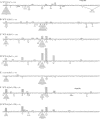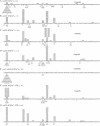The in vivo characterization of translesion synthesis across UV-induced lesions in Saccharomyces cerevisiae: insights into Pol zeta- and Pol eta-dependent frameshift mutagenesis
- PMID: 16387871
- PMCID: PMC1456278
- DOI: 10.1534/genetics.105.052480
The in vivo characterization of translesion synthesis across UV-induced lesions in Saccharomyces cerevisiae: insights into Pol zeta- and Pol eta-dependent frameshift mutagenesis
Abstract
UV irradiation, a known carcinogen, induces the formation of dipyrimidine dimers with the predominant lesions being cyclobutane pyrimidine dimers (CPDs) and pyrimidine (6-4) pyrimidone adducts (6-4PPs). The relative roles of the yeast translesion synthesis DNA polymerases Pol zeta and Pol eta in UV survival and mutagenesis were examined using strains deficient in one or both polymerases. In addition, photoreactivation was used to specifically remove CPDs, thus allowing an estimate to be made of the relative contributions of CPDs vs. 6-4PPs to overall survival and mutagenesis. In terms of UV-induced mutagenesis, we focused on the +1 frameshift mutations detected by reversion of the lys2deltaA746 allele, as Pol zeta produces a distinct mutational signature in this assay. Results suggest that CPDs are responsible for most of the UV-associated toxicity as well as for the majority of UV-induced frameshift mutations in yeast. Although the presence of Pol eta generally suppresses UV-induced mutagenesis, our data suggest a role for this polymerase in generating some classes of +1 frameshifts. Finally, the examination of frameshift reversion spectra indicates a hierarchy between Pol eta and Pol zeta with respect to the bypass of UV-induced lesions.
Figures

 ), rev3 (▴,
), rev3 (▴,  ), rad30 (▪,
), rad30 (▪,  ), and rev3 rad30 (×) strains are shown. Error bars correspond to the standard deviation. (C and D) The relative toxicities of CPDs (open symbols) vs. 6-4PPs (shaded symbols) in the rev3 and rad30 mutants, respectively. The toxicity associated with CPDs at a given UV dose was calculated by dividing the UV − PR survival at that dose by UV + PR survival.
), and rev3 rad30 (×) strains are shown. Error bars correspond to the standard deviation. (C and D) The relative toxicities of CPDs (open symbols) vs. 6-4PPs (shaded symbols) in the rev3 and rad30 mutants, respectively. The toxicity associated with CPDs at a given UV dose was calculated by dividing the UV − PR survival at that dose by UV + PR survival.




References
-
- Armstrong, J. D., and B. A. Kunz, 1992. Photoreactivation implicates cyclobutane dimers as the major promutagenic UVB lesions in yeast. Mutat. Res. 268: 83–94. - PubMed
-
- Barbour, L., and W. Xiao, 2003. Regulation of alternative replication bypass pathways at stalled replication forks and its effects on genome stability: a yeast model. Mutat. Res. 532: 137–155. - PubMed
-
- Baynton, K., A. Bresswon-Roy and R. P. P. Fuchs, 1999. Distinct roles for Rev1p and Rev7p during translesion synthesis in Saccharomyces cerevisiae. Mol. Microbiol. 34: 124–133. - PubMed
Publication types
MeSH terms
Substances
Grants and funding
LinkOut - more resources
Full Text Sources
Molecular Biology Databases

